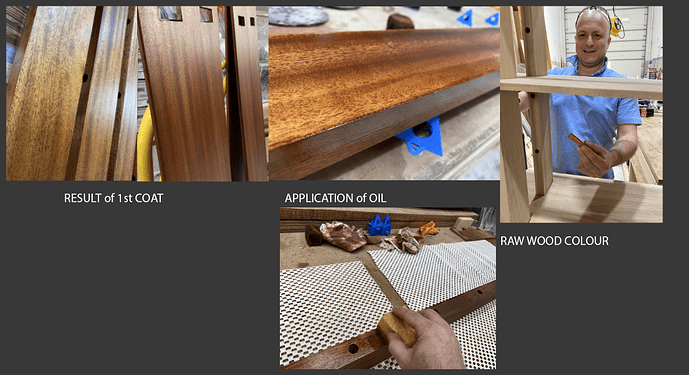What do you use to “fix” coloured stain to allow final fine finishing?
What aim i doing wrong??
Both water based and spirit stain/dye bleed into the brush when I apply acrylic lacquer after the stain has been left to dry for at least a day in a warm dry room, (tried various makes!)
Making small drawers (bandsaw box) using fine sanded pine. (Spraying finish lacquer would be difficult so been using hair brush or foam brush).
Hampshire sheen suggests (optional!) Oil (presume finishing oil!) Then an appropriate sealer, then finish.
Q) What “oil” would you recommend? Would it not bleed (melt!) The stain even more than water based??
The boxes I have been colour staining are whimsical type where I use multiple colours on the different parts (draw & knob for example)
What am I doing wrong? Or is it a know issue that people don’t talk about on forums etc??
Thanks!
Fwiw, I never, ever, stain anything as for me, it makes the whole finishing process that much more complicated. I use one main wood and one, perhaps two timbers for ‘accent’ details (knobs, drawer pulls etc)
Most folk I know use Osmo-PolyX of some sort for their finishing; it’s easy to apply and more or less fool proof, provided that you don’t apply thick, gloopy coats.
Thanks for response Woodbloke.
I too prefer making using hardwood, letting the real colour of the wood shine through.
Also used osmo-polyx, enjoy using it (lots of very thin coats over a number of days!). My go to quick finish at the mo is Cellulose sand n seal, then spray lacquer and wax (ready to sell in a day!)
These boxes are another range of eye catching boxes that add to my range.
Question still outstanding!
Hi Joe,
Nick from Malta here, I occasionally use stain on things like african walnut, to get it more warm in colour and closer to american walnut. I use dye’s, such is liberon spirt dye. I find that this is what works best for me:
I apply the stain using a dense sponge (like a cut up grouting sponge) works better then a rag.
I wait a minimum of 48hrs after applying the dye before doing anything else!
I mostly use oil finishes on top, either pure tung oil, or a mixed oil such as Festools onestep oil (it has a minimal qty of wax in it)
i also apply the oil by sponge, wait 15 + min, if i still have think amounts of oil pooled up i lightly wipe that off with a clean rag before is work the oil in using festools green viles (you do not have to use the orbital sander for this, you can also use the vile by hand and Hermes have similar ones, also available from axminster.
after that i wipe the piece dry with a clean rag.
I do get a minimal amount of colour rubbing into the vile but hardly any!
Here is animages of the result (i took a screenshot of a couple of images together because i am only allowed to upload one image)
Cheers,
Nick
Never tried stain on pine. But with Hampshire sheen the oil mentioned is Danish oil followed by acrylic sand and sealer ( dries quicker). Yes there is still some colour bleed .
I use either hampshire sheen intrinsic colours which are watwr based or chestnut spirit stains which are spirit based. I apply these to bare sanded wood. After that I will use a sanding sealer ‘opposite’ to the stain I used. So I will use a cellulose sanding sealer with water based stains and acrylic sealer with spirit stains. If you spray the sealer rather than rub or paint it on then there is no bleed. After two or three THIN coats allowing each coat to dry in between then you are ready for your choice of finish. Remember that sanding sealer coats need to be thin, better 2-3 thin coats than thick gloopy coats. This is very important. A popular finishing process is after denibbing the sealed coats then apply hampshire sheen high gloss finish then microcrystalline wax. You can use a heat gun to lightly melt the first wax finish before buffing to a shine. Don’t heat the final microcrystalline finish.
Alternatively, try a danish oil finish after the sanding sealer. Hope that helps
Hi Joe,
The easiest stain to apply is oil stain, as it takes longer to dry and should be suitable for use with an acrylic lacquer. Don’t be confused by the word oil, Oil Stain is simply a generic name and has nothing to do with finishing oils.
Apply the oil stain quickly with a cotton rag, wipe off immediately with a clean cotton rag, then leave to dry for 24 hours. The wood will have absorbed what it can. If you don’t wipe it off, you will have a sticky film of oil stain on the surface.
There are basically three types of wood stain, water based, oil based, and spirit based. The easiest approach when applying a finish by brush, is to use a stain that is not based on the same type of solvent as the finish. Otherwise, the brushing action will dissolve and lift the stain.
Use what type of solvent is required to clean your brushes as a general guide.
Turps/white spirit = oil based
Alcohol/methylated spirits = spirit based
Water = water based (such as acrylic lacquer)
Hope this is helpful.
Jeff
Applying sanding sealer with a brush can also cause the colours to run and merge. When I do this type of work I spray clear lacquer whether cellulose or acrylic.


